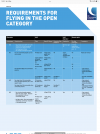From what I know, so far while EASA has released general guidelines for the various drone classes, so far they have not released the final rules on what a drone OEM needs to do to comply with Class 1, Class 2 rules etc.
According to their website, 'Drones with a class identification label (i.e. C0, C1, C2, C3, C4) are expected to become commercially available by 2022' .
For drone pilots that follow the rules, this is going to be a huge deal as it opens up a whole new world of drones that can be flown in the A1 category, as well as reducing the potential distance requirements for uninvolved people from 50m to as little as 5m in the A2 class.
However the question is obviously 'when', and additionally whether drones on the market now will get retroactive classification, and whether existing drones will need to be sent to the manufacturer physically for certifcation.
No way I am buying the M3 until there's more clarity on this.
According to their website, 'Drones with a class identification label (i.e. C0, C1, C2, C3, C4) are expected to become commercially available by 2022' .
For drone pilots that follow the rules, this is going to be a huge deal as it opens up a whole new world of drones that can be flown in the A1 category, as well as reducing the potential distance requirements for uninvolved people from 50m to as little as 5m in the A2 class.
However the question is obviously 'when', and additionally whether drones on the market now will get retroactive classification, and whether existing drones will need to be sent to the manufacturer physically for certifcation.
No way I am buying the M3 until there's more clarity on this.











